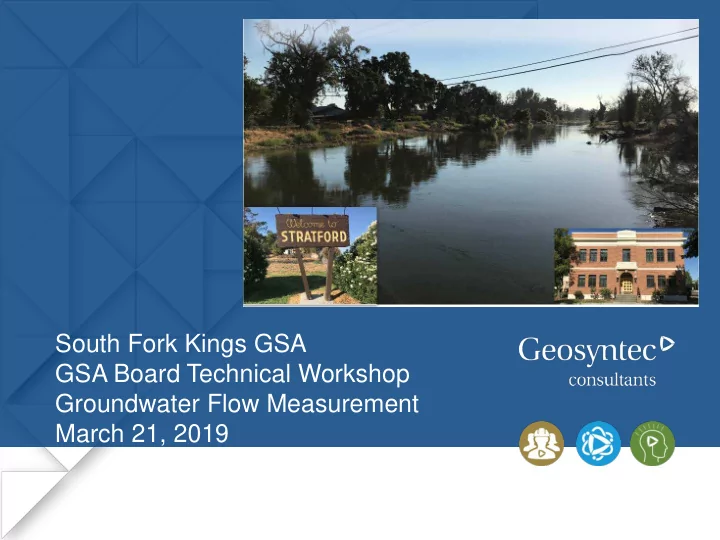

South Fork Kings GSA GSA Board Technical Workshop Groundwater Flow Measurement March 21, 2019
Workshop Overview • Brief hydrogeology review – Semi-confined aquifer • Measurement program discussion – Why measure? – What to measure – How to measure it – Pros/cons discussion
Limit of “usable” groundwater Perched Aquifer (A-Zone) “A-Clay” “C-Clay” Semi-Confined Aquifer (B-Zone) “E-Clay” Confined Aquifer (C-Zone)
E-Clay + C-Clay + A-Clay No A, C or E A + C + E-Clay Perched Semi-Confined Semi-Confined Confined No A or E C-Clay + E-Clay Semi-Confined Confined Semi-Confined Confined
Observed Groundwater Levels 250 Perched “A-Clay” 150 50 Semi- “C-Clay” -50 Confined WL ELev (ft MSL) -150 -250 Corcoran Clay (E-Clay) -350 “E-Clay” -450 Confined -550 1988 1993 1998 2003 2008 2013 2018
• Why Measure? • How to Measure It? • Pros and Cons
Why Measure Groundwater Pumping? Groundwater Use SGMA Monitoring, Projects and Management Actions SGMA Undesirable Effects From Pumping SGMA Compliance Water-Level
SFKGSA Sustainability Projection 250 “A-Clay” 150 50 -50 WL ELev (ft MSL) “C-Clay” -150 -250 -350 “E-Clay” -450 Corcoran Clay (E-Clay) -550 1960 1965 1970 1975 1980 1985 1990 1995 2000 2005 2010 2015 2020 2025 2030 2035 2040 20S20E28E003M 20S19E25A003M 18S20E34N001M
SFKGSA Sustainability Projection 300,000 250,000 Estimated Actual Pumping Total Water Supply Used 200,000 150,000 100,000 Sustainable yield range (based on modeling to date) 50,000 - 1990 1995 2000 2005 2010 2015 2020 2025 2030 2035 2040
Pumping Measurement • Why Measure? – Groundwater levels – Groundwater pumping • How to Measure It? – Direct – Indirect • Pros and Cons
Direct vs Indirect – Summary Direct (Flow Meter) Indirect (Remote Sensing) A physical measurement of flow at A calculation of flow based on crop a wellhead or irrigation delivery imaging measurements Measures total use, not Calculates consumptive use, not consumptive use total use Deep recharge, crop ET, irrigation Total pumping, deep recharge, efficiency and return flow are irrigation efficiency and return flow separate calculations are separate calculations Preferred data for modeling and Acceptable (not preferred) for credits/trading modeling and credits/trading Individual wells can combine to Parcel-based only (cannot parcel level distinguish individual wells)
SFKGSA Parcel Summary Total Cumulative Cumulative Cumulative Cumulative Parcel size # of parcels Acreage Parcels Acres % of Parcels % of Acres >640 acres 4 2626 4 2,626 0% 3% 320-640 acres 28 12,135 32 14,761 0% 19% 160-320 acres 80 18,245 112 33,006 1% 41% 80-160 acres 126 15,422 238 48,428 3% 61% 40-80 acres 207 12,867 445 61,295 5% 77% 20-40 acres 277 8799 722 70,094 8% 88% 10-20 acres 290 4523 1,012 74,617 11% 94% 5-10 acres 232 1787 1,244 76,404 14% 96% 2-5 acres 384 1213 1,628 77,617 18% 98% <2 acres 7,284 1984 8,912 79,601 100% 100%
Flow Meters • Flow Meter Types – Propeller/Turbine – Electromagnetic – Acoustic/Ultrasonic
Meter Installation Considerations
Wellhead Requirements Maintenance Calibration Record-keeping
Direct Measurement Methods • Power Consumption – Utility records – “Smart” meters – No wellhead mods – Accuracy varies
Pump power consumption related to flow (OPPE) Operating performance relates to power consumption
Direct Measurement Methods • Data Capture – Remote vs manual – Reporting structure – Installation, O&M – QA/QC • Data Management – Database/GIS – Collection frequency – Data processing and workflow – Confidentiality – Parcel vs well
Indirect Measurement Methods • Satellite Imagery – USGS/LANDSAT – European (ESA) – Commercial Services
Indirect Measurement Methods • Crop-Type Detection – USDA/NASS (National Agricultural Statistics Service – CropScape “CDL” (Crop Detection Layer) – Available online and published annually
CropScape Crop Type History Example The equation relating crop type to satellite wavelength reflectance is not 100% accurate Pistachio Pomegranate
CropScape Crop Type History Example Tomato Grain Alfalfa
Indirect Measurement Methods • “METRIC” – Evapotranspiration (ETo) Detection – Developed in Idaho (2007)
Indirect Measurement Methods • “METRIC-ITRC” – Customized to California Climate Conditions – Cal Poly Irrigation Technology Research Center (ITRC) Does NOT Identify crop type….. only consumptive water use
Indirect Measurement Methods • Image processing platform – Public (USDA) – Custom (ESA) – Proprietary (Commercial) – Academia (METRIC-ITRC) • Data Management – Database/GIS – Collection frequency – Data processing & workflow – Parcel only
Local-Scale Survey Methods • Landowner Survey – Mail/Electronic/Web – Workshops – Ground truthing – “Piggy-back” with other programs
Landowner Survey of Water Use Cumulative Cumulative Parcel size Parcels Acreage Parcels Acres >640 acres 4 2,626 4 2,626 320-640 acres 28 12,135 32 14,761 160-320 acres 80 18,245 112 33,006 80-160 acres 126 15,422 238 48,428 40-80 acres 207 12,867 445 61,295 20-40 acres 277 8,799 722 70,094 10-20 acres 290 4,523 1,012 74,617 5-10 acres 232 1,787 1,244 76,404 2-5 acres 384 1,213 1,628 77,617 >2 acres 7,284 1,984 8,912 79,601 Water Use Un- Permanent Annual Parcel size metered Crop Crop Metered Drip Sprinkler Other >640 acres 320-640 acres 160-320 acres 80-160 acres 40-80 acres 20-40 acres 10-20 acres 5-10 acres 2-5 acres >2 acres
Local-Scale Survey Methods • Survey Design – Collection frequency – Data requested – Confidentiality – Coordination – Response rate • Data Management – Database/GIS – Data processing & workflow – Parcel only
Enforcement • Regardless of measurement approach, SFKGSA may need to take enforcement actions based on measurement data • Data on which actions are taken should be defensible and aligned with the type of action taken – Indirect (land cover) monitoring may be sufficient to support voluntary actions and incentives to manage pumping. – Direct pumping measurement would be required to monitor and enforce pumping restrictions. – Groundwater credits/trading may require both. • All parcels do not necessarily need to be measured the same way
Phased Combination of Methods 1. Remote Sensing 1. USDA/CropScape 2. Landowner Survey (>5-10 acres) a. Mail/Electronic/Web/Workshops b. Ground Truthing 3. Voluntary “Opt-in” Measurement (>5-10 acres) a. Pumping/well data (direct) b. Crop type & irrigation (indirect) c. Other (direct/indirect) 4. Mandatory Measurement a. Pumping/well data b. Crop type & irrigation data Increasing Accuracy Over Time 5. Enforcement
Thank You Questions/Discussion
Recommend
More recommend